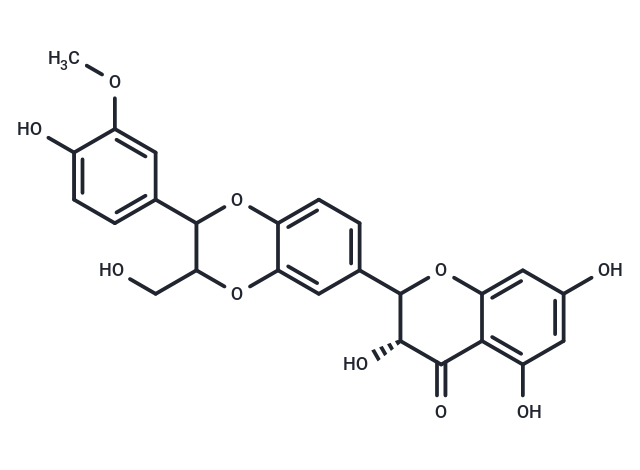Shopping Cart
Remove All Your shopping cart is currently empty
Your shopping cart is currently empty
Isosilybin (Isosilibinin) and Silybin might be suitable candidates to design potent PXR antagonists to prevent drug-drug interactions via CYP3A4 in cancer patients.

| Pack Size | Price | USA Warehouse | Global Warehouse | Quantity |
|---|---|---|---|---|
| 1 mg | $30 | In Stock | In Stock | |
| 5 mg | $68 | In Stock | In Stock | |
| 10 mg | $105 | In Stock | In Stock | |
| 25 mg | $228 | In Stock | In Stock | |
| 50 mg | $425 | In Stock | In Stock | |
| 100 mg | $628 | - | In Stock | |
| 1 mL x 10 mM (in DMSO) | $72 | In Stock | In Stock |
| Description | Isosilybin (Isosilibinin) and Silybin might be suitable candidates to design potent PXR antagonists to prevent drug-drug interactions via CYP3A4 in cancer patients. |
| Targets&IC50 | CYP3A4:74 μM. |
| In vitro | The reporter gene assay demonstrates that the milk thistle constituents silybin and isosilybin inhibit the PXR-mediated induction of CYP3A4, with isosilybin being a more potent inhibitor. Concentrations of 89, 133, and 200 μM of isosilybin decrease CYP3A4 induction by 64, 82, and 88%, respectively, and achieve an IC50 of 74 μM[1]. Additionally, the diastereoisomers isosilybin B and isosilybin A, derived from silymarin, exhibit anti-prostate cancer (PCA) activity through cell cycle arrest and apoptosis induction in human prostate cancer cells LNCaP and 22Rv1[2]. Isosilybin B enhances phosphorylation of Akt and Mdm2, leading to androgen receptor degradation, which is reversed by PI3K inhibitor pretreatment. This process facilitates the formation of a complex that promotes phosphorylation-dependent ubiquitination and subsequent degradation of the androgen receptor[3]. Isosilybin A significantly activates PPARγ at a 30 μM concentration, leading to a concentration-dependent transactivation of a PPARγ-dependent luciferase reporter. In silico docking studies indicate isosilybin A interacts with the receptor's ligand-binding domain through an additional hydrogen bond not found with inactive silymarin constituents[4]. |
| Cell Research | LNCaP cells and 22Rv1 cells are plated and treated at 40–50% confluency with different doses of isosilybin B and isosilybin A (10–90 μM in medium) dissolved originally in Dimethyl sulfoxide (DMSO) for the desired time periods (24–48 h) in serum condition. An equal amount of DMSO (vehicle) is present in each treatment, including control; DMSO concentration did not exceed 0.1% (v/v) in any treatment. At the end of desired treatments, total cell number is determined by counting each sample in duplicate using a hemocytometer under an inverted microscope. Cell viability is determined using trypan blue exclusion method[2]. |
| Synonyms | Isosilybinin, Isosilibinin |
| Molecular Weight | 482.44 |
| Formula | C25H22O10 |
| Cas No. | 72581-71-6 |
| Smiles | COc1cc(ccc1O)C1Oc2ccc(cc2OC1CO)C1Oc2cc(O)cc(O)c2C(=O)[C@@H]1O |
| Relative Density. | 1.527 g/cm3 (Predicted) |
| Storage | Powder: -20°C for 3 years | In solvent: -80°C for 1 year | Shipping with blue ice/Shipping at ambient temperature. | |||||||||||||||||||||||||||||||||||
| Solubility Information | DMSO: 88 mg/mL (182.41 mM), Sonication is recommended. Chloroform, Dichloromethane, Ethyl Acetate: Soluble | |||||||||||||||||||||||||||||||||||
| In Vivo Formulation | 10% DMSO+40% PEG300+5% Tween 80+45% Saline: 3.3 mg/mL (6.84 mM), Sonication is recommended. Please add the solvents sequentially, clarifying the solution as much as possible before adding the next one. Dissolve by heating and/or sonication if necessary. Working solution is recommended to be prepared and used immediately. The formulation provided above is for reference purposes only. In vivo formulations may vary and should be modified based on specific experimental conditions. | |||||||||||||||||||||||||||||||||||
Solution Preparation Table | ||||||||||||||||||||||||||||||||||||
DMSO
| ||||||||||||||||||||||||||||||||||||
| Size | Quantity | Unit Price | Amount | Operation |
|---|

Copyright © 2015-2025 TargetMol Chemicals Inc. All Rights Reserved.